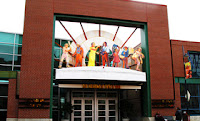The road back to life began in 1989 when then Mayor Emmanuel Cleaver (now U.S. Congressman Cleaver) focused attention on the decay and worked tirelessly to direct resources toward a revival. Today we have a stable, if not thriving, historic district. A world-class jazz museum and a baseball museum dedicated to the Negro Leagues anchor the area. Both have struggled for years with gaining traction and support locally to the level that they deserve. Additionally many millions more have been invested to build a new community center, apartments and several store front retail locations. But as Mr. Reynolds points out, the area still feels more like a movie back lot than an authentic neighborhood. But why?
Obviously the remaining faux facades that dot the area from a 1996 film shot there creates an air of in-authenticity. But it goes deeper than the building facades. Simply put, the area is trapped in time. In it's desperate attempt to preserve the history of the area it is overlooking it's future. 18th & Vine became a place of innovation and legend in the early 20th century not because it was trying to preserve something of it's past, but because it was looking to the future. It was, at it's core, a place of entrepreneurship and of innovation. A creative think tank that served as a melting pot for crossover ideas. While it was a true African-American neighborhood, it was open to all. This was in sharp contrast to the white dominated areas that sought to keep non-whites out. Naturally, a wide-open place like the Jazz District attracted the creative class of whites, immigrants, Jews and more. All learned from, and contributed to the scene there. What was exported was nothing short of genius. So how do we recapture this big idea?
"18th & Vine became a place
of innovation and legend in
the early 20th century not
because it was trying to preserve
something of it's past,
but because it was looking
to the future."
The Jazz District will return to prosperity when it thinks less about being a museum and more about being a hub of revolutionary arts and culture. Make no mistake, the heritage and the museums are crucial to this occurring. They need to think more like a modern art galleries, and curate the explorers. The neighborhood should become a place that recruits new immigrants to Kansas City. Create global art and technology incubators and offer restaurant incubators. The leaders of the District have started to embrace this. They should double down on this idea and push forward like never before. 18th & Vine is where culture and new ideas are created and where the world discovers them. The physical neighborhood must continue to be restored too, of course. More sidewalk retail and residential must be built. Millions more must be invested in infrastructure. Better connectivity and transportation must be established. However, the biggest change could simply be in marketing, branding and communications. Stop thinking of 18th & Vine as just a historic place that should be placed under glass, and start thinking of it as a place that has always catered to the revolutionaries and the creative class. Life for the future with the past as inspiration.


No comments:
Post a Comment